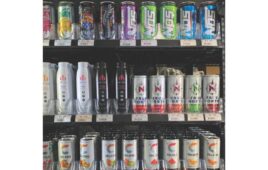 Exponential growth in usage and innovative packaging lead some experts to believe e-tobacco may be the wave of the future.
Exponential growth in usage and innovative packaging lead some experts to believe e-tobacco may be the wave of the future.
By Bob Phillips, Contributing Editor.
In fiction there was Roy Hobbs, the athletic prodigy who came, unheard of, out of the Iowa cornfields to take the world by storm. In real life there is Mike Trout, the wunderkind from New Jersey—a real-life Roy Hobbs, who does it all and has become an MVP candidate at the age of 21. In beverages, there are energy drinks, the once-upon-a-niche segment that has morphed into a $1.5 billion monster—and expected to reach $2 billion in annual retail sales by 2016.
And now, add electronic cigarettes to that list.
Started as an Internet phenomenon, e-cigs have their roots in China and first made their way to this side of the world in the mid-1990s. Still a niche product at retail, the promise of future fortune has industry experts and convenience retailers alike buzzing about the category’s potential.
“It’s a fairly new category, and that’s what I find so exciting,” said Bonnie Herzog, senior market analyst at Wells Fargo. “I’m making some pretty big predictions. I think it’s possible that consumption of e-cigarettes could surpass that of traditional cigarettes within the next decade.”
Herzog likens e-cigs to energy drinks in terms of growth, profit potential…and buzz.
“Remember when energy drinks first hit the market?” she continued. “People were saying, ‘Is it a fad, or is it a trend? What’s going on?’ I do think there are some similarities here.”
Like energy drinks a decade ago, e-cigarettes is a category in its retail infancy. According to Wells Fargo, e-cigarettes currently generate roughly $300 million at retail. But like energy drinks, that number is expected to grow exponentially—developing into a $1 billion category and offering gross margins comparable to traditional cigarettes, within a decade.
Some industry insiders, including Tom Kiklas, co-founder and spokesman for the Tobacco Vapor Electronic Cigarette Association (TVECA), expect the $1 billion barrier to be cracked in less than half that time. According to Kiklas, there are currently 1.5 million e-cigarette users. And while that number pales next to the 46 million Americans who consume traditional tobacco products, there is one key difference between the two segments: e-cigs are growing, while tobacco-based cigarettes are in decline.
“E-cigarettes are a very small category right now,” agreed Herzog. “But because the product’s attributes are so similar to traditional cigarettes, this makes them very attractive to existing smokers. The operative assumption is that the risk is reduced because you’re inhaling vapor. The notion that they offer the same sensation with less harm is an attractive proposition to a large group of consumers.”
‘New Age’ Tobacco
Indeed, e-cigs share two key attributes with the once burgeoning and now maturing New Age beverage category: added value in terms of perceived health benefits by consumers, and innovation by manufacturers. E-cigarette manufacturers are not allowed to make health claims. If they did so, they would be subject to much tighter FDA regulations. But word of mouth is perhaps the most powerful marketing tool ever devised, and many experts predict that individual states will soon be jumping into the act to pull in the reins on e-cigs—at least as it pertains to young-adult or even teenage consumption.
“There’s no question in my mind that you will see states putting restrictions on them—and rightly so, because they could be considered a gateway [to tobacco usage],” Herzog said. “The consumer right now is the traditional smoker.”
This dynamic is similar to what retailers have seen in beverages, where consumers have gravitated in large numbers toward those products that are perceived to be better for you (i.e. sugar-free, caffeine-free and fat-free products).
“Say your spouse doesn’t want you smoking,” Herzog said. “He or she doesn’t like the smell. Well, here; you can smoke this.”
The enormous appeal of e-cigarettes stems from a variety of perceived advantages over traditional cigarettes. Not only are they perceived as healthier, but also cheaper and far more convenient. They can be used almost anywhere because no smoke is inhaled or exhaled; only vapor.
“It was cool to be able to light up while walking through a Walmart,” said Mark Rivera, an e-cigarette consumer in Stratford, Conn., adding that “no-smoking” laws did not apply to e-cigs in his region.
Garnering Attention
And here’s another way that the e-cigarette category mirrors new age beverages: Once a few brands gained some legs in the marketplace, the big boys were quick to dive headlong into the water. Lorillard was the first in when the tobacco behemoth acquired all assets of blu e-cigarettes—one of the leading brands in the e-cig market—in a cash transaction this past spring. Wells Fargo predicts other major tobacco companies will likely follow Lorillard’s lead.
On the flip side of being a gateway into the tobacco category, there are consumers who use e-cigarettes as a smoking cessation tool.
“I absolutely think that people are using it that way,” noted Herzog. “But maybe they don’t quit. Maybe they enjoy it. I know many smokers who enjoy consuming tobacco, but they don’t like the risk. I think it’s going to evolve; I think you’re going to see it regulated and taxed. Only Minnesota has an OTP (other tobacco product) tax on it right now, but there’s no question in my mind that you will see states putting restrictions on them. But the consumer right now is the traditional smoker.”
Regulation Issues
Last April, the FDA announced its plans to regulate e-cigarettes as tobacco products and will work with the Bureau of Alcohol, Tobacco, Firearms and Explosives (ATF) to tax and regulate distribution, which means e-cigarette importers must have tobacco importing licenses, and sellers must have tobacco licenses in all 50 states.
States are still figuring out how to deal with e-cigarettes. In Hawaii, for example, the product was up against a proposal that aimed to tax e-cigarettes at 70% of the wholesale price. Luckily for Hawaiian retailers, the bill was not passed.
“We have no problem with the taxing of the product, but you have to tax it at the level of harm that it does, and it’s a less harmful product than a traditional tobacco cigarette,” Kiklas said. “So if you’re going to tax it, tax it at that level, and that level would be not very high.”
New Product Excitement
Tedeschi has been testing disposable and rechargeable e-cigarette brands at 15 of its 190 stores, and is also testing the refill cartridges.
“I don’t see the hype right now that seems to be prevalent in other parts of the country for e-cigarettes. It doesn’t seem to have reached New England yet, or at least the state of Massachusetts,” said Stephen Monaco, director of purchasing for Tedeschi Food Shops in Rockland, Mass. “But I believe electronic cigarettes and cigars are here to stay and will become more dominant as the year goes along.”
At Express Convenience Centers in Wisconsin, e-cigarette unit sales are low, but the company sees the sales and margins on electronic tobacco products as worth the investment, said Scott Glaser, merchandising manager and buyer for the 19-store chain.
“We do have a few committed e-cigarette customers, but it’s too soon to tell if customers are trading off from other tobacco categories or if they are capturing an entirely new customer,” Glaser said.




